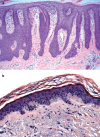Angiogenesis drives psoriasis pathogenesis
- PMID: 19563608
- PMCID: PMC2697548
- DOI: 10.1111/j.1365-2613.2009.00669.x
Angiogenesis drives psoriasis pathogenesis
Abstract
Psoriasis pathogenesis is closely associated with disease-inducing Th1 and Th17 cells. Yet, several studies suggest that aberrant keratinocyte or endothelial cell signalling significantly contributes to disease manifestation. Histological hallmarks of psoriatic skin include the infiltration of multiple immune cells, keratinocyte proliferation and increased dermal vascularity. Formation of new blood vessels starts with early psoriatic changes and disappears with disease clearance. Several angiogenic mediators like vascular endothelial growth factor, hypoxia-inducible factors, angiopoietins and pro-angiogenic cytokines, such as tumour necrosis factor (TNF), interleukin (IL)-8 and IL-17, are up-regulated in psoriasis development. Contact- and mediator-dependent factors derived from keratinocytes, mast cells and immune cells may contribute to the strong blood vessel formation of psoriasis. New technologies and experimental models provide new insights into the role of angiogenesis in psoriasis pathogenesis. Interestingly, many therapies target not only immune cells, but also protein structures of endothelial cells. Here we summarize the role of pro-angiogenic factors in psoriasis development and discuss angiogenesis as a potential target of novel therapies.
Figures




References
-
- Al-Daraji WI, Grant KR, Ryan K, Saxton A, Reynolds NJ. Localization of calcineurin/NFAT in human skin and psoriasis and inhibition of calcineurin/NFAT activation in human keratinocytes by cyclosporin A. J. Invest. Dermatol. 2002;118:779–788. - PubMed
-
- Austin LM, Ozawa M, Kikuchi T, Walters IB, Krueger JG. The majority of epidermal T cells in psoriasis vulgaris lesions can produce type 1 cytokines, interferon-gamma, interleukin-2, and tumor necrosis factor-alpha, defining TC1 (cytotoxic T lymphocyte) and TH1 effector populations: a type 1 differentiation bias is also measured in circulating blood T cells in psoriatic patients. J. Invest. Dermatol. 1999;113:752–759. - PubMed
-
- Baggiolini M, Dewald B, Moser B. Human chemokines: an update. Annu. Rev. Immunol. 1997;15:675–705. - PubMed
-
- Bhushan M, McLaughlin B, Weiss JB, Griffiths CE. Levels of endothelial cell stimulating angiogenesis factor and vascular endothelial growth factor are elevated in psoriasis. Br. J. Dermatol. 1999;141:1054–1060. - PubMed
Publication types
MeSH terms
Substances
LinkOut - more resources
Full Text Sources
Other Literature Sources
Medical

